

Shakespeare, SOLO taxonomy and taking risks (Part 1) I have an interview on Monday.

For me the most stressful part of interview preparation is getting the lesson right. I’m happy to take criticism over almost anything else but I really don’t want to hear that my teaching is anything less than outstanding. Why? Because it’s what I do all day. If I can’t put together an outstanding lesson at an interview then, frankly, what’s the point? But, as we all know, interview lessons are highly artificial. How to make use of QR codes with your iPad (teachers & students!) iPad Published on July 25th, 2012 | by Mark Anderson It has been recognised for some time now that using QR codes can really support learning but how can the iPad support the use of QR codes in the classroom?

Well the fact that it has the camera built in makes it super-handy for working in the classroom with QR codes, but how can they be used to support learning, what methods can you employ in order to create them and then share them? A QR code (or Quick Response code) is like a bar code, in that it can be scanned with a reader and it will present some information based upon what is held within the code. In the case of a bar code it is normally a number which corresponds with a product or ISBN number or similar. URL (website address)Email addressPhone numberTextvCardSMSYouTube clipFacebook profileWi-Fi detailsTwitter profileMap coordinate Now the idea is that you have an app that will create the code and the information is held within it. IPads, SOLO and a History Lesson. Kerry ⋅ History, iPads ⋅ History, iPads, Pinterest, Skitch, SOLO ⋅ 1 comment I always enjoy our Year 8 History day trip to the Leeds Armouries; despite the budget cuts, the education staff work hard to make it a memorable visit.

Our focus for the day is on soldiers, arms and armour of the English Civil War. (1642 – 1651) The students take part in workshops and complete a worksheet on what they’ve seen in the galleries. On our return to the classroom, we review the day’s learning; consolidate the topic and extend the students with further learning in preparation for a post exam project on an aspect of the Civil War. SOLO Taxonomy versus Bloom's Taxonomy. The SOLO Taxonomy (Biggs & Collis, 1982), provides a measure of cognitive learning outcomes or understanding of thinking, that, in my experience, teachers have felt comfortable adopting.
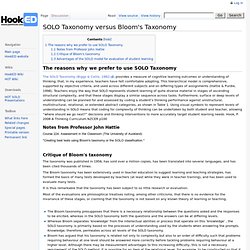
This hierarchical model is comprehensive, supported by objective criteria, and used across different subjects and on differing types of assignments (Hattie & Purdie, 1998). Teachers enjoy the way that SOLO represents student learning of quite diverse material in stages of ascending structural complexity, and that these stages display a similar sequence across tasks.
Furthermore, surface or deep levels of understanding can be planned for and assessed by coding a student’s thinking performance against unistructural, multistructural, relational, or extended abstract categories, as shown in Table 1. Using visual symbols to represent levels of understanding in SOLO means that coding for complexity of thinking can be undertaken by both student and teacher, allowing “where should we go next?” Knowledge. BSRLM-IP-26-3-10. Reflections Of A Learning Geek. What am I doing? HOT SOLO Presentations. From HookED Wiki Using SOLO Taxonomy in teaching and learning.
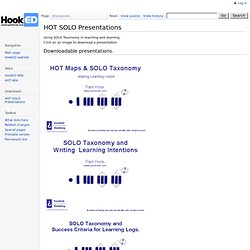
Click on an image to download a presentation. SOLO_Taxonomy_and_HOT_Maps. SOLO Taxonomy. SOLO Taxonomy (structure of observed learning outcomes) provides a simple, reliable and robust model for three levels of understanding – surface deep and conceptual (Biggs and Collis 1982).
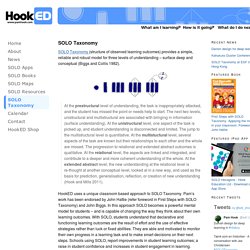
At the prestructural level of understanding, the task is inappropriately attacked, and the student has missed the point or needs help to start. The next two levels, unistructural and multistructural are associated with bringing in information (surface understanding). At the unistructural level, one aspect of the task is picked up, and student understanding is disconnected and limited. The jump to the multistructural level is quantitative. Solo Taxonomy. Solo Taxonomy. Solo Taxonomy has been sitting on my to do list for a while.
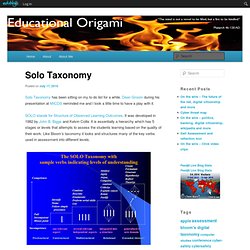
Dean Groom during his presentation at MICDS reminded me and I took a little time to have a play with it. SOLO stands for Structure of Observed Learning Outcomes. It was developed in 1982 by John B. Biggs and Kelvin Collis. SOLO taxonomy. I am pleased to say that John Biggs himself has endorsed this representation of his ideas; "I've just found your website on SOLO et al. via google.

I'm delighted! Your diagrams of prestructural-extended abstract are very elegant... " (Unsolicited email, 29 May 2005) Using SOLO, mark schemes and hexagons to target A* Unit 1 exam responses. After looking at SOLO taxonomy to introduce poetry to Year 7s, I’ve used the structures to teach a variety of topics within English.
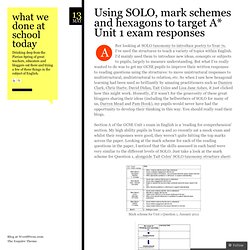
I’d mainly used them to introduce new ideas, concepts or subjects to pupils, largely to measure understanding. But what I’ve really wanted to do was to get my GCSE pupils to improve their written responses to reading questions using the structures: to move unistructural responses to multistructural, multistructural to relation, etc. So when I saw how hexagonal learning had been used so brilliantly by amazing practitioners such as Damien Clark, Chris Harte, David Didau, Tait Coles and Lisa Jane Ashes, it just clicked how this might work.
Honestly, if it wasn’t for the generosity of these great bloggers sharing their ideas (including the bellwethers of SOLO for many of us, Darren Mead and Pam Hook), my pupils would never have had the opportunity to develop their thinking in this way. You should really read their blogs. Like this: Using SOLO Levels to Revise; Lesson 1 Writing Prep. Reflections of a Learning Geek. Solo stations with IPads « Mcintosh8's Blog. As Solo taxonomy is such an integral part of my teaching now I wanted to see how it could be combined with our recent purchase of iPads here at Rossett School.
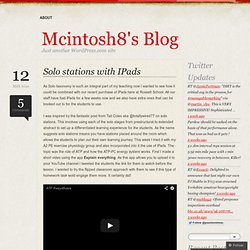
All our staff have had iPads for a few weeks now and we also have extra ones that can be booked out to for the students to use. I was inspired by the fantastic post from Tait Coles aka @totallywired77 on solo stations. This involves using each of the solo stages from prestructural to extended abstract to set up a differentiated learning experience for the students. As the name suggests solo stations means you have stations placed around the room which allows the students to plan out their own learning journey.
This week I tried it with my A2 PE exercise physiology group and also incorporated into it the use of iPads. The lesson itself started with a short Socrative app quiz on simple uni and multistructural questions on ATP & the ATP-PC energy system. SOLO Taxonomy. SOLO Taxonomy - The Hexagon Challenge! The Power Of Solo taxonomy! Using SOLO for Intervention (part 2) As I explored in my earlier post, I have had the fantastic task of running a group for our intervention. We had selected several students, 50 in total to carry out controlled assessments. I had a group of 21 students, from the C/D borderline mostly, and one or two below.
We had decided to extend the group we were targeting to ensure that, while we focus on the C/D borderline to boost our headline figures, we also targeted a number of the weaker students to ensure they also made progress (and obviously, this is now reported in the league tables). The group I had contained a number of challenging students and we had our work cut out for us as we had 5 hours to complete the intervention, from scratch a piece on the spoken language study. Structure and Resources. Update on SOLO taxonomy in Geography GCSE. Nottingham High School's Modern Foreign Languages Department. Want to write good essays? Posted on 05. May, 2012 by Mr Picardo in A2 , A2 , A2 , AS , AS , AS , Deutsch , Español , Français , Languages When it comes to writing essays in the foreign language, students generally find it difficult to make the leap from the narrations and descriptions required for GCSE to the more sophisticated deeper analysis and structured evaluation required at A Level.
Above, you can see a word cloud made from the AQA AS and A2 content assessment criteria , clearly highlighting what you need in order to access the highest grades in writing: relevance, evidence, structure and evaluation are all key requirements. The traditional concept of introduction , followed by main body and culminating in a conclusion offers a basic structure that you can follow to construct your essay. So, what can you do to hone those essay writing skills to ensure that you always submit your best possible work? 1. Read the exam question carefully. Step Two – Link Other Relevant Aspects. Sharing Pedagogical Purposes. Learning Intention Generator. SOLO Stations. There seems to an awful lot of excellent posts written about SOLO Taxonomy at the moment, which is obviously absolutely fantastic …..I just thought I’d best write one to keep up with the very high standard of reflection and sharing! The idea for SOLO Stations came from a great blog post from @DVPLearning found here in the post Steven describes a Year 10 PE Revision lesson in which “He then explained what the next task was going to be.
This is where teach, do, review comes in! Half The Teaching = Double The Learning: First Attempt at SOLO Learning. As a teacher of PE I feel it is important to promote independent learning wherever possible. I always structure my practical lesson in a fashion which allows me to set tasks which will show the students making progress and also build up their confidence in the sport which we are doing. However this is something, which on reflection, I could improve on my theory side of things. My GCSE group are fast approaching their exam.
Previous exam analysis has shown that students in the main have not got the highest grades because they do not answer the longer questions because they do not look at the bigger picture of what the question is asking. Half The Teaching = Double The Learning. SOLO taxonomy. SOLO and Theory of Effective Learning Part 1. Information Processing and Learning. The power of solo taxonomy! « Mcintosh8's Blog.